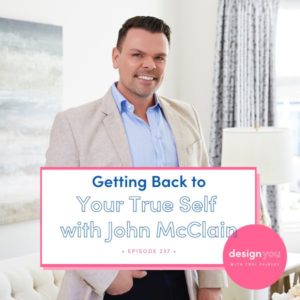
We are socialized to want to feel validated, and important, and the way we do that is by always measuring ourselves against other people. We’re always deciding where we are on the ladder compared to others, but what if we focused on ourselves? What if we focused on showing up in a real, authentic, and honest way and validating ourselves?
I love bringing friends onto the show, and I’m so excited to introduce you to today’s guest, CEO and Creative Director of John McClain Design. John is an accomplished Interior Designer, Speaker, Business Coach, and on-air Contributor who has businesses in Florida and California. He is the author of The Designer Within: A Professional Guide to a Well-Styled Home, and he helps other designers streamline their businesses and get back to their true selves.
In this episode, hear how John is helping so many people with his gifts and talents and the work he is doing to change the world. We talk about the importance of doing things in your own way – not following the ways of other people – and how showing up as your true self is such an important way to run your business.





